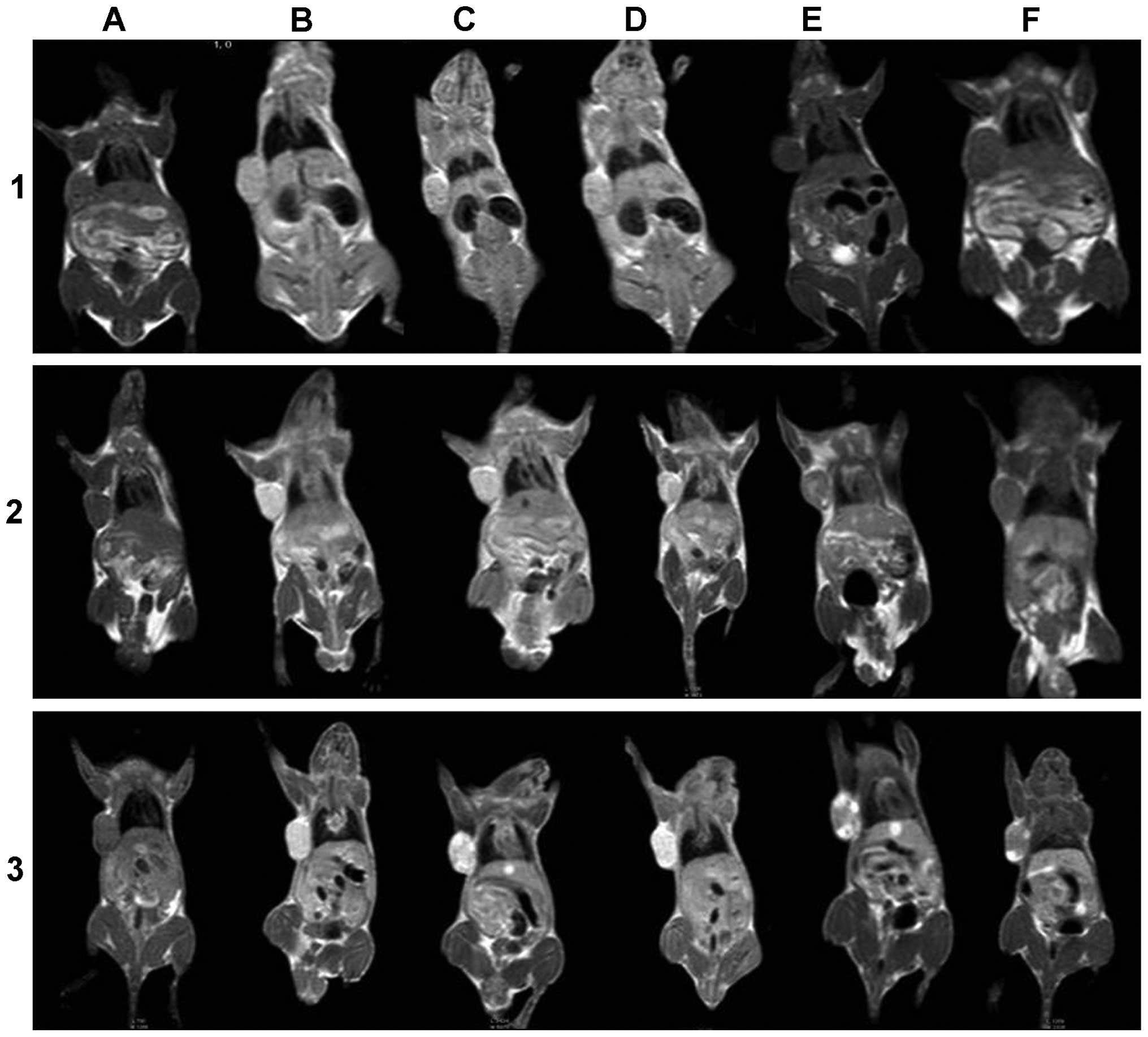|
1
|
Weissleder R: Molecular imaging in cancer.
Science. 312:1168–1171. 2006. View Article : Google Scholar : PubMed/NCBI
|
|
2
|
Hu F, Joshi HM, Dravid VP and Meade TJ:
High-performance nanostructured MR contrast probes. Nanoscale.
2:1884–1891. 2010. View Article : Google Scholar : PubMed/NCBI
|
|
3
|
Moffat BA, Reddy GR, McConville P, Hall
DE, Chenevert TL, Kopelman RR, Philbert M, Weissleder R, Rehemtulla
A and Ross BD: A novel polyacrylamide magnetic nanoparticle
contrast agent for molecular imaging using MRI. Mol Imaging.
2:324–332. 2003. View Article : Google Scholar
|
|
4
|
Vosjan MJ, Vercammen J, Kolkman JA,
Stigter-van Walsum M, Revets H and van Dongen GA: Nanobodies
targeting the hepatocyte growth factor: Potential new drugs for
molecular cancer therapy. Mol Cancer Ther. 11:1017–1025. 2012.
View Article : Google Scholar : PubMed/NCBI
|
|
5
|
Garanger E, Boturyn D and Dumy P: Tumor
targeting with RGD peptide ligands-design of new molecular
conjugates for imaging and therapy of cancers. Anticancer Agents
Med Chem. 7:552–558. 2007. View Article : Google Scholar : PubMed/NCBI
|
|
6
|
Chen X, Liu S, Hou Y, Tohme M, Park R,
Bading JR and Conti PS: MicroPET imaging of breast cancer
alphav-integrin expression with 64Cu-labeled dimeric RGD peptides.
Mol Imaging Biol. 6:350–359. 2004. View Article : Google Scholar : PubMed/NCBI
|
|
7
|
Chen X, Tohme M, Park R, Hou Y, Bading JR
and Conti PS: Micro-PET imaging of alphavbeta3-integrin expression
with 18F-labeled dimeric RGD peptide. Mol Imaging. 3:96–104. 2004.
View Article : Google Scholar : PubMed/NCBI
|
|
8
|
Haubner R, Wester HJ, Weber WA, Mang C,
Ziegler SI, Goodman SL, Senekowitsch-Schmidtke R, Kessler H and
Schwaiger M: Noninvasive imaging of alpha(v)beta3 integrin
expression using 18F-labeled RGD-containing glycopeptide and
positron emission tomography. Cancer Res. 61:1781–1785.
2001.PubMed/NCBI
|
|
9
|
Oliveira S, Heukers R, Sornkom J, Kok RJ,
van Bergen En and Henegouwen PM: Targeting tumors with nanobodies
for cancer imaging and therapy. J Control Release. 172:607–617.
2013. View Article : Google Scholar : PubMed/NCBI
|
|
10
|
Huang L, Gainkam LO, Caveliers V, Vanhove
C, Keyaerts M, De Baetselier P, Bossuyt A, Revets H and Lahoutte T:
SPECT imaging with 99mTc-labeled EGFR-specific nanobody for in vivo
monitoring of EGFR expression. Mol Imaging Biol. 10:167–175. 2008.
View Article : Google Scholar : PubMed/NCBI
|
|
11
|
Vosjan MJ, Perk LR, Roovers RC, Visser GW,
Stigter-van Walsum M, van Bergen En, Henegouwen PM and van Dongen
GA: Facile labelling of an anti-epidermal growth factor receptor
Nanobody with 68Ga via a novel bifunctional desferal chelate for
immuno-PET. Eur J Nucl Med Mol Imaging. 38:753–763. 2011.
View Article : Google Scholar : PubMed/NCBI
|
|
12
|
Haspel N, Zanuy D, Nussinov R, Teesalu T,
Ruoslahti E and Aleman C: Binding of a C-end rule peptide to the
neuropilin-1 receptor: A molecular modeling approach. Biochemistry.
50:1755–1762. 2011. View Article : Google Scholar : PubMed/NCBI
|
|
13
|
Sugahara KN, Teesalu T, Karmali PP,
Kotamraju VR, Agemy L, Girard OM, Hanahan D, Mattrey RF and
Ruoslahti E: Tissue-penetrating delivery of compounds and
nanoparticles into tumors. Cancer Cell. 16:510–520. 2009.
View Article : Google Scholar : PubMed/NCBI
|
|
14
|
Hiki S and Kataoka K: Versatile and
selective synthesis of 'click chemistry' compatible
heterobifunctional poly(ethylene glycol)s possessing azide and
alkyne functionalities. Bioconjug Chem. 21:248–254. 2010.
View Article : Google Scholar : PubMed/NCBI
|
|
15
|
Hoang B, Lee H, Reilly RM and Allen C:
Noninvasive monitoring of the fate of 111In-labeled block copolymer
micelles by high resolution and high sensitivity microSPECT/CT
imaging. Mol Pharm. 6:581–592. 2009. View Article : Google Scholar : PubMed/NCBI
|
|
16
|
Ishihara T, Maeda T, Sakamoto H, Takasaki
N, Shigyo M, Ishida T, Kiwada H, Mizushima Y and Mizushima T:
Evasion of the accelerated blood clearance phenomenon by coating of
nanoparticles with various hydrophilic polymers. Biomacromolecules.
11:2700–2706. 2010. View Article : Google Scholar : PubMed/NCBI
|
|
17
|
Sha H, Zou Z, Xin K, Bian X, Cai X, Lu W,
Chen J, Chen G, Huang L, Blair AM, et al: Tumor-penetrating peptide
fused EGFR single-domain antibody enhances cancer drug penetration
into 3D multicellular spheroids and facilitates effective gastric
cancer therapy. J Control Release. 200:188–200. 2014. View Article : Google Scholar
|
|
18
|
Kielar F, Tei L, Terreno E and Botta M:
Large relaxivity enhancement of paramagnetic lipid nanoparticles by
restricting the local motions of the Gd(III) chelates. J Am Chem
Soc. 132:7836–7837. 2010. View Article : Google Scholar : PubMed/NCBI
|
|
19
|
Prudêncio M, Rohovec J, Peters JA, Tocheva
E, Boulanger MJ, Murphy ME, Hupkes HJ, Kosters W, Impagliazzo A and
Ubbink M: A caged lanthanide complex as a paramagnetic shift agent
for protein NMR. Chemistry. 10:3252–3260. 2004. View Article : Google Scholar : PubMed/NCBI
|
|
20
|
Uppal R and Caravan P: Targeted probes for
cardiovascular MRI. Future Med Chem. 2:451–470. 2010. View Article : Google Scholar : PubMed/NCBI
|
|
21
|
Sugahara KN, Teesalu T, Karmali PP,
Kotamraju VR, Agemy L, Greenwald DR and Ruoslahti E:
Coadministration of a tumor-penetrating peptide enhances the
efficacy of cancer drugs. Science. 328:1031–1035. 2010. View Article : Google Scholar : PubMed/NCBI
|
|
22
|
Sugahara KN, Braun GB, de Mendoza TH,
Kotamraju VR, French RP, Lowy AM, Teesalu T and Ruoslahti E: Tumor-
penetrating iRGD peptide inhibits metastasis. Mol Cancer Ther.
14:120–128. 2015. View Article : Google Scholar :
|



















